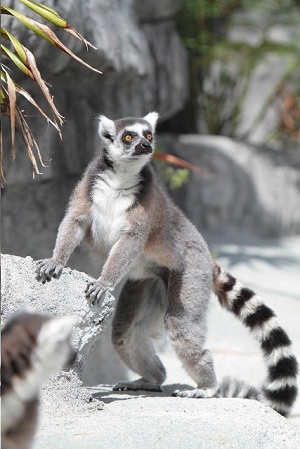Three New Lemurs At Zoo’s Madagascar Exhibit
Three new Bermuda residents — a trio of ring-tailed lemurs — are getting used to their home inside the Madagascar Exhibit at Bermuda Aquarium, Museum & Zoo.
The Zoo’s free-flight, walk-through exhibit will be temporarily closed to the public until early June while the lemurs settles into their new surroundings.
“We are delighted to add these fascinating creatures to this world-class exhibit so that our visitors, particularly students and children, can see and learn about the endangered animals of Madagascar and other threatened islands,” says Dr. Ian Walker, BAMZ Principal Curator. “We ask people to be patient while these animals get comfortable inside the exhibit before it is re-opened to visitors.”
The lemurs—a male called Elmer and two unrelated sisters, Petunia and Penelope—came from Sacramento Zoo in California, where they had lived together as a family unit. “They are very comfortable around people,” says Dr. Walker, adding there are no plans to breed the lemurs.
Madagascar: Land of Mystery and Wonder opened last November—the first large new exhibit in a decade at BAMZ, underscoring the facility’s mission “to inspire appreciation and care of island environments.” It was funded by lead sponsor HSBC in partnership with the Bermuda Government, Bermuda Zoological Society (BZS), the Department of Conservation Services, plus corporate and private donors.
The exhibit links Bermuda’s own conservation challenges with those of Madagascar—where a majority of plants and animals are found nowhere else on earth. Lemurs are one of Madgascar’s endemic animals—with an astonishing 80 different species, ranging from tiny pygmies to child-size creatures. Lemurs live in many regions of the Indian Ocean island, but their habitats are fast disappearing.
The Zoo exhibit showcases Madagascar’s diversity by highlighting features such as caves, a waterfall, wetlands, and the limestone fortresses of the biodiverse northern Tsingy region. The three new lemurs can roam freely on the exhibit’s large shady trees and impressive rockscapes that are fashioned to mimic the cathedral-like limestone towers of the Tsingy region.
Other compelling species already featured in the exhibit include tiny mantella frogs, tomato frogs, ground boas, endangered radiated tortoises, African helmeted turtles, buttonquails and a cat-like fossa—Madagascar’s top predator.
“The introduction of lemurs to the Madagascar Exhibit adds another dimension to what we hope will be an educational and entertaining attraction to residents and Bermuda visitors,” says Dr Walker.
BZS is the support charity for Bermuda Aquarium, Museum & Zoo, funding a full slate of education programmes, conservation and research projects, exhibits and community outreach events. BAMZ is a Bermuda government institution within the Department of Conservation Services.
- Photo credit: Dr. Ian Walker
Read More About
Category: All, Environment, News




Is it really necessary to keep animals in captivity period? In the age of global travel, internet and tv, I think not. For one, these animals have nothing to do with Bermuda and two, it’s disturbing watching these imprisoned animals going round in circles or trying to find a way out… Seen those two Otters? It’s great to educate people on these magnificent creatures but zoo’s and aquariums pave the way to more unethical organisations “stealing” these animals directly from their natural habitat which is ironic, considering the word ‘endangered’ is mentioned. Just remember, we might visit these places once a year and spend 5 minutes at the most admiring these creatures, but to them, it’s a lifetime. Furthermore, it’s far more for-filling to save your money and go on a once-in-a-lifetime trip to see some of these animals in their natural environment, if your really that interested in the animals to begin with.
There are certainly pros and cons to the display of animals in captivity. I think though that you will find that all the workers at the Aquarium and Zoo would strongly oppose the idea that the animals on display are there for entertainment purposes. Rather, I think they would describe the display as primarily one of education – raising awareness – and secondly one of conservation, both direct and indirect.
By education, I mean raising awareness of the problems these animals face in the wild, and helping develop an appreciation of ‘nature’, thus helping to inform conservation in the long-term. The Madagascar exhibit in question tries very hard to make the connection between human political/economic issues and threats to wildlife in their natural habitat, for example.
By direct conservation, BAMZ is part of a captive breeding program initiative that (a) breeds endangered animals for release back into the wild, thus bolstering wild populations; and (b) ensure that zoos only display captive-bred animals rather than ‘wild’ ones poached from their natural environment. The success of this is, of course, open to debate.
By indirect conservation, I mean the educational component, but also in as much as the revenue generated (mostly to the NGO BZS, through donations, rather than BAMZ, part of the Gov DoConservation, as the revenue at the door likely only barely covers running costs) is used to fund both educational outreach programs and conservation research in/on Bermuda.
So, sure, there are pros and cons, but it’s not a simple black and white thing of viewing zoo animals as captive entertainment for consumer-based capitalism. Of course the focus should be on protecting and expanding the natural habitats of these animals, and, sure, go travel to their habitats and contribute money to that purpose, but there are other alternative approaches which may be equally good (or bad).
freedom. At least they have a home.
As for travelling the world and seeing all this natrual, well get real.
Many Bermudians have never seen a squid or parrot fish.
Then again, for some it’s all about me.
So glad to see the Lemurs have arrived. My son will be so happy. He has been asking to see them since the exhibit has opened. We spend alot of time at the aquarium and zoo.
Just don’t touch the feet!
A vote for the OBA is a vote for more lemurs in captivity! lol
His is that if the PLP is the party in power and allowed them to bring them in?
Its sarcasm, but i wonder if the got perminant residency status like the Uighers…